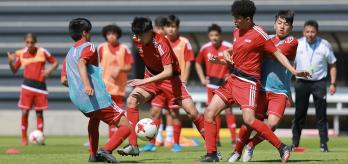Dr Coutinho is a specialist in designing small-sided games for training. In this presentation, he outlines some of the latest research on the long-term effects of training programmes featuring small-sided games in a dynamic and changing environment, and considers how they can complement more traditional, “closed” drills that take place in predictable and static environments. He concludes the session by exploring how playing small-sided games under particularly unusual conditions can help players to develop their tactical awareness and find new approaches to the 11-a-side game.
Set out recent research regarding the effects of small-sided games on players’ performance. Examine the potential to integrate different learning techniques into small-sided games and the benefits this might bring for players and coaches.
More research is required in this area, but there are indications that dynamic small-sided games might be more effective than predictable closed drills in developing a number of important technical and physical attributes. They also have the potential to encourage tactical creativity and make players more positionally aware.
Coaches should consider incorporating small-sided games into their training sessions alongside other complementary drills.
Watch video
Read summary
Part 1: Key principles of small-sided games
Dr Coutinho begins his session with a summary of the most important points to bear in mind when designing and using small-sided games (for a more detailed discussion of the scientific literature in this area, readers can find the first part of his presentation here). He emphasises that they give coaches complete freedom to invent their own bespoke rules for each training exercise, which allows them to manipulate certain constraints and thus encourage players to behave a certain way during these drills. He also gives a brief outline of the acute effects that can be produced in individual small-sided exercises.
Part 2: Effects on technical and physical performance
Following this introduction, the second part of the session delves into recent studies on small-sided exercises to examine the long-term effects of this training method on players’ technical and physical ability. This research is still in its infancy, but there are indications that dynamic small-sided games might be superior to predictable technical drills when it comes to developing crucial skills like decision-making, pass accuracy and dribbling. In addition, there is also some evidence suggesting they can help to improve aerobic performance.
Part 3: Small-sided games for tactical awareness
To end the presentation, Dr Coutinho considers how small-sided games can be used to sharpen tactical awareness. Small-sided training exercises give coaches scope to incorporate different learning techniques into training exercises, and they can exploit that freedom to invent some powerful training-ground tools. For example, modifying the rules to make players play with eye patches over one eye, or making them train on an uneven surface, can encourage them to move more creatively on the pitch and prompt them to find their own solutions to a unique set of circumstances.
Q&A
01:07
Can we expect the same positive outcomes from small-sided games when they are applied in a real-life game scenario?
02:58
As a coach, how can you ensure your players develop their technical skills in a uniform way using these exercises? What advice would you give coaches on that?
05:29
As far as the physical qualities of players are concerned, are small-sided games a poor method of developing high-speed running and sprinting ability?
07:54
Some fascinating science has been produced on things like synchronisation and coordination in small-sided games, and how that can affect tactical awareness. How does that research relate to real-life practice?
10:56
You mentioned variability and learning. How can coaches add variability into individual sessions and, over the longer-term, into their training programmes more widely?
13:08
Differential learning is a hot topic in football. What is the short-term impact of playing on an uneven surface or a hill, or of making players wear an eye patch, for instance? It must have a detrimental effect on short-term performance, mustn’t it? What are the long-term benefits?
17:31
Do you think small-sided games should be the main training task used in training sessions, or should they be used as a more complementary training task alongside other exercises?
18:53
As a researcher, where do you think this research needs to go in order toto inform practice in the future?
20:09
What basic tips would you give practitioners about training interventions that feature small-sided games?


 16-9.variant64x64.JPG)









 16-9.variant348x164.JPG)






